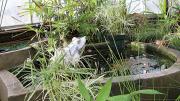In the rear of the Hydrophyte House is a worn wooden bench where visitors may sit and listen to the burbling of a frog-shaped fountain and the erratic hissing of old pipes. Tropical pitcher plants hanging from baskets above ingest stray bugs, vines roam the walls, and stalks of sugar cane grow thick in one corner. Taking in the greenery and warm, moist air makes it possible to forgive the frigid winds swirling madly beyond the glass. “There’s always something growing, if not blooming, in the greenhouses,” says Gail Kahn, assistant director of the 22-acre Wellesley College Botanic Gardens, which include the Margaret C. Ferguson Greenhouses, completed in 1923. These shelter more than 1,100 specimens, many of them old and rare. There are black pepper plants; a Guadalupe palm and calabash and tamarind trees; cacti; bromeliads; and cycads. The 131-year-old camellia originally belonged to the college’s founders, Pauline and Henry Fowle Durant, A.B. 1841. Passionate horticulturists, the couple opened their collection of warm-weather plants to students, who also explored the flora growing in the meadows, woods, and waterways on and around the still-bucolic campus. Research and education remain the focus, but all visitors are welcome. Go soon to “catch sight of a Bird of Paradise in bloom,” says Kahn, “or the powder puff tree and some of the orchids.” Or even just to appreciate the historic greenhouses themselves. As early as this spring, they will be torn down to make way for replacements equipped with the most efficient climate-control systems and amenities. “They are charming and wonderful,” Kahn agrees, “but also past their prime.”
The Wellesley College Botanic Gardens offer an escape from winter
The Wellesley College Botanic Gardens offer an escape from winter
The greenhouses at Wellesley College Botanic Gardens offer greenery and blossoms in winter.


You might also like
Mount Vernon, Historic Preservation, and American Politics
Anne Neal Petri promotes George Washington and historic literacy.
Creepy Crawlies and Sticky Murder Weapons at Harvard
In the shadows of Singapore’s forests, an ancient predator lies in wait—the velvet worm.
Rachel Ruysch’s Lush (Still) Life
Now on display at the Museum of Fine Arts, a Dutch painter’s art proved a treasure trove for scientists.
Most popular
Explore More From Current Issue

This TikTok Artist Combines Monsters and Mental Heath
Ava Jinying Salzman’s artwork helps people process difficult feelings.

Novelist Lev Grossman on Why Fantasy Isn’t About Escapism
The Magicians author discusses his influences, from Harvard to King Arthur to Tolkien.

For Campus Speech, Civility is a Cultural Practice
A former Harvard College dean reviews Princeton President Christopher Eisgruber’s book Terms of Respect.





